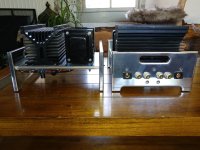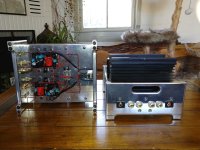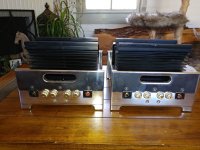...Is why this forum must exist. Manufacturers are dealing with out-sourcing that is the bane to every fabricator.use parts purchased and tested by others.
Case in point:
Called Mouser on Iron Pre Ribbons. Datasheets had eroneous info. They called the manufacturer for a quote to order the exact parts needed. Quote came back for completely wrong parts. What do you do with that?
Order by guess and hope. Return if you have to.
Well that can happen at the store too if they don't have exactly what you want. Anyway, I get my meanwell locally too, since mouser can't ship them to Greece
Yes, if your heat sink can take a bit of extra heat.I ordered a pair of 24V Meanwell versions from Amazon. Can I use these with the 193T chokes?
If you up the current from 1.7A to 2.0A, the distortion will also drop. Again if your heat sink can take a bit of extra heat.
The extra Voltage will bump up the maximum output power too.
The store has saved us many headaches.happen at the store too
At max. V it gets warm with the 193V. My whole chassis is heatsink. Can put on more H/S's if needed. M.R. is correct. Nice foot warmers...If you up the current from 1.7A to 2.0A, the distortion will also drop. Again if your heat sink can take a bit of extra heat.
Ah you meant THE store... now it makes sense... sorry it has been a long dayThe store
Yes! W/O we have no place to go. Esp with the help provided.THE store...
It seems that both Lundahl LL2733 and Lundahl LL1694 have been used here with coils in parallel. Is there an advantage in using the bigger LL2733 versus the cheaper LL1694 for a Big MoFo?If someone wanted to go all out on parts my guess is the Lundahl LL2733 filament current choke may work well. It has two coils which you can put in series or parallel. In series it gives 400mH at a recommended current of 1.7A saturating at 2.7A. Or in parallel it gives 100mH with a recommended current of 3.4A saturating at 5.4A. It's $100 from K&k audio (no affiliation). The LL1694 is also a contender. They claim to wind and gap them as meticulously as there audio transformers and IMO they look sexy if indeed a choke is capable of looking sexy.
@Peppe
Posts 669 and 3181.
In my opinion, more inductance, more better, as long as it is compatible with the current demands imposed on the choke. You want the choke to be in a comfortable place and the datasheet tells you at what current it is saturating. I built the Big MoFo and wanted a choke that could utilize the current requirements of that design. I also use the amplifier with near full range speakers.
If your design requirements don’t require a ton of bass (i.e. less than 50Hz), I could see the use of a smaller choke and less inductance (in example, an amplifier for just midrange/tweeters In an active setup).
Bear in mind, that more bias current will also decrease overall THD so a bigger choke is nice to have.
Best,
Anand.
Posts 669 and 3181.
In my opinion, more inductance, more better, as long as it is compatible with the current demands imposed on the choke. You want the choke to be in a comfortable place and the datasheet tells you at what current it is saturating. I built the Big MoFo and wanted a choke that could utilize the current requirements of that design. I also use the amplifier with near full range speakers.
If your design requirements don’t require a ton of bass (i.e. less than 50Hz), I could see the use of a smaller choke and less inductance (in example, an amplifier for just midrange/tweeters In an active setup).
Bear in mind, that more bias current will also decrease overall THD so a bigger choke is nice to have.
Best,
Anand.
Thanks Anad. And superb monoblocks!
Considering a bias point of 2.5A at 24V, both choke models seems to be far from the saturating current (5.4A for LL2733 and 4.8A for LL1694). The LL1694 has a minor DCR (0.5R vs. 0.9R for the LL2733) that seems to be preferable. Quoting Mike's article:
So, the LL2733 has on paper just a larger inductance (0.1H vs 0.04H) as advantage over the LL1694. Is the difference quatificable (on paper of course) in terms of frequency response?
Considering a bias point of 2.5A at 24V, both choke models seems to be far from the saturating current (5.4A for LL2733 and 4.8A for LL1694). The LL1694 has a minor DCR (0.5R vs. 0.9R for the LL2733) that seems to be preferable. Quoting Mike's article:
Ideally, you want your inductor to have low DC resistance so you don’t drop a lot of voltage.
So, the LL2733 has on paper just a larger inductance (0.1H vs 0.04H) as advantage over the LL1694. Is the difference quatificable (on paper of course) in terms of frequency response?
So, the LL2733 has on paper just a larger inductance (0.1H vs 0.04H) as advantage over the LL1694. Is the difference quatificable (on paper of course) in terms of frequency response?
Great question, although I am blanking on the reactance equation to calculate the -3dB frequency for inductance. Maybe Inductive reactance (XL) = 2*pi*F*L;
Help from Ben Mah, ZenMod, 6L6, etc... required!!

P.S. I looked at the voltage drop of 0.5R vs 0.9R and it was immaterial to be honest. If it's an issue, just design for a higher supply voltage to compensate. You do understand that the 24V recommendation isn't a hard stop recommendation. You can go a little above and things are okay. You just deal with more heat dissipation in the sinks. So you need bigger sinks if your sinks are small to begin with. In my build, with the 3U heatsinks, I didn't like the feel of 55 degrees C. So I dropped my current to 2.25A instead and it runs a little cooler. This is a flexible design.
Best,
Anand.
Last edited:
The 24V is because of toroid and caps in stock for a linear supply. Heatsinks should be 4U/300. Nothing written in stone though.
Here is a high pass filter calculator online:
High pass filter calculator
For a RL filter, the -3dB frequency = R/(2 x Pi x L)
Michael Rothacher in his Mofo article gave the output impedance of the mosfet source follower as 0.17 Ohms.
40mH should not be a problem. Michael used a Hammond 195T that has an inductance of 50mH. He charted the frequency response with that in the Mofo and there was no problem with the frequency response.
If the low frequency -3dB cutoff is calculated, it is 0.7 hz for 40mH and 0.17 Ohm.
The output RC has a higher cutoff frequency.
High pass filter calculator
For a RL filter, the -3dB frequency = R/(2 x Pi x L)
Michael Rothacher in his Mofo article gave the output impedance of the mosfet source follower as 0.17 Ohms.
40mH should not be a problem. Michael used a Hammond 195T that has an inductance of 50mH. He charted the frequency response with that in the Mofo and there was no problem with the frequency response.
If the low frequency -3dB cutoff is calculated, it is 0.7 hz for 40mH and 0.17 Ohm.
The output RC has a higher cutoff frequency.
- Home
- Amplifiers
- Pass Labs
- Build This MoFo!



